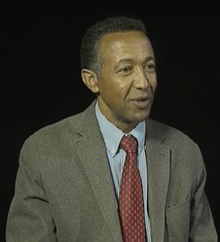Yohannes Haile-Selassie
Yohannes Haile-Selassie Ambaye (born on 23 February 1961 in Adigrat, Tigray Region) is an Ethiopian paleoanthropologist. An authority on pre-Homo sapiens hominids, he particularly focuses his attention on the East African Rift and Middle Awash valleys.[2]
Yohannes Haile-Selassie Ambaye | |
|---|---|
 Yohannes Haile-Selassie | |
| Born | Yohannes Haile Selassie 23 February 1961[1] |
| Nationality | Ethiopian |
| Alma mater |
|
| Known for | |
| Scientific career | |
| Fields | Archeology |
| Institutions | |
| Thesis | Late Miocene Mammalian Fauna from the Middle Awash Valley, Ethiopia (2001) |
| Doctoral advisor | Tim D. White |
Biography
Yohannes began his tertiary education at the Addis Ababa University in Addis Ababa, graduating in the summer of 1982 with a B.A. degree in history. His first job was at the Center for Research and Conservation of Cultural Heritage in Addis Ababa.[3]
His graduate education began at the University of California, Berkeley, where Yohannes was mentored by Tim White and earned an M.A. in Anthropology in 1995 and a Ph.D. in Integrative Biology in 2001.[4] In 2002, he became the Curator and Head of Physical Anthropology Department at the Cleveland Museum of Natural History in Cleveland, Ohio, where he works currently. He serves as an Adjunct Professor of Anthropology and Anatomy at Case Western Reserve University and as an Adjunct Associate Professor at the Institute of Paleoenvironment and Heritage Conservation, Mekelle University.
Yohannes is well known in the field of paleoanthropology for having a gift for fossil spotting, with his first fossil hunting expedition (White's Middle Awash Project) taking place in 1990. He has been instrumental in the discoveries of the type specimen (principal reference fossil) for Australopithecus garhi and Ardipithecus kadabba (both discovered in 1997), and he has also found fossil specimens of Ardipithecus ramidus, Australopithecus afarensis, and species of Homo including Homo erectus, as well as Homo sapiens. Since 2004, he has led digs in the Mille woreda of the Afar Region of Ethiopia (the Woranso-Mille Project). In June 2010, Yohannes published a paper describing Kadanuumuu, one of the specimens his group found in Afar.[5]
The research conducted by Yohannes has been primarily funded by the Leakey Foundation.[6] He has published in the American Journal of Physical Anthropology and Nature.[7][8]
References
- "WATSON, Prof. James Dewey". Who's Who. ukwhoswho.com. 2015 (online Oxford University Press ed.). A & C Black, an imprint of Bloomsbury Publishing plc. (subscription or UK public library membership required) (subscription required)
- Mangels, John (2004-07). Fossil Hunter Transcripts. The Plain Dealer, July 2004. Retrieved on 2014-09-12 from http://www.cleveland.com/sundaymag/plaindealer/index.ssf?/sundaymag/more/fossil04.html.
- "Curriculum Vitae Yohannes Haile-Selassie Ambaye" (PDF). Cleveland Museum of Natural History. 2015.
- "Late Miocene mammalian fauna from the Middle Awash Valley, Ethiopia". 2001. ProQuest 304683965. Cite journal requires
|journal=(help) - Rex Dalton (2010-06-20). "Africa's next top hominid:Ancient human relative could walk upright". Nature.
- "The Leakey Foundation |". www.leakeyfoundation.org. Retrieved 2017-10-25.
- Haile-Selassie, Yohannes (2009). "New hominid fossils from Woranso-Mille (Central Afar, Ethiopia) and taxonomy of early Australopithecus". American Journal of Physical Anthropology. 141 (3): 406–17. doi:10.1002/ajpa.21159. PMID 19918995.
- Haile-Selassie, Y.; Gibert, L.; Melillo, S. M.; Ryan, T. M.; Alene, M.; Deino, A.; Levin, N. E.; Scott, G.; Saylor, B. Z. (2015). "New species from Ethiopia further expands Middle Pliocene hominin diversity". Nature. 521 (7553): 483–8. Bibcode:2015Natur.521..483H. doi:10.1038/nature14448. PMID 26017448. "New species from Ethiopia further expands Middle Pliocene hominin diversity"
External links
- Yohannes Haile-Selassie page at Cleveland Museum of Natural History site
- Yohannes Haile-Selassie interview from The Plain Dealer
- Article about Yohannes Haile-Selassie from The Plain Dealer
- Article about discovery of hominid remains (May 2015)
- Yohannes Haile-Selassie at Pubmed